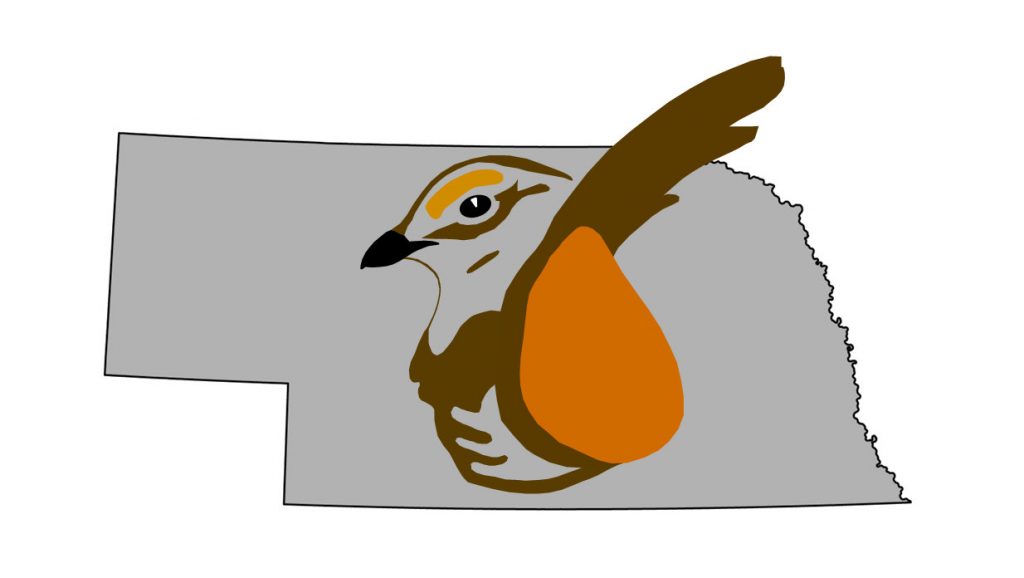Anser leucopsis
Status: No accepted records.
Taxonomy: No subspecies are recognized (Gill et al 2022).
A mounted specimen shot from a flock of about 40 “Hutch” Canada Geese (now known as Cackling Goose, Branta hutchinsii) 2 Nov 1968 in Otoe Co (Cortelyou 1969) was assumed for many years to be an escaped Barnacle Goose, but reexamination of the specimen determined that this 1968 mounted specimen is a hybrid with Cackling Goose: Barnacle Goose x Cackling Goose (hybrid) – Birds of Nebraska – Online (outdoornebraska.gov).
Comments: Barnacle Goose, like Pink-footed Goose, is experiencing a dramatic population increase and its status in North America reflects this; unlike Pink-footed Goose however, Barnacle Goose is popular in collections, which presents a challenge to Bird Records Committees attempting to determine provenance (Howell et al 2014), although the case for occurrence of wild birds reaching the interior United States was made by Mlodinow and O’Brien (1996).
Barnacle Goose is casual Oct-Apr in the northeastern United States, with reports south to Colorado, Texas, and the Gulf Coast, and, while many may be escaped birds, there are banding recoveries of European birds, including one banded in Islay, Scotland, Nov 2004 as a juvenile that was shot by a hunter in eastern Ontario, Canada in fall 2005 (Ron Pittaway, Jean Iron, Post to ID-Frontiers). A genetic study on about 1000 white-cheeked goose tail fans conducted in Canada to determine if DNA analysis could be used to track these species for hunting control purposes found that two Cackling Goose tails had Barnacle Goose mitochondrial DNA (Jim Leafloor, Steve Mlodinow, personal communication). Leafloor noted that this may have resulted from an escaped Barnacle Goose, but also a wild bird living with Cackling Geese in the high arctic.
There are numerous records westward through the Great Lakes, including several in Wisconsin and Illinois (eBird.org, accessed Apr 2023); The Arkansas Rare Birds Committee recently accepted that state’s first record, a bird in central Arkansas 27-31 Dec 2010 (eBird.org, accessed Apr 2023). There are two accepted records for Colorado, 9 Jan 2018 in Arapahoe Co and 6 Jan 2019 in Weld Co (Colorado Bird Records Committee, accessed Aug 2020; eBird.org, accessed Apr 2023), and one for Colfax Co, New Mexico 8 Dec 2007-2 Feb 2008 (eBird.org, accessed Apri 2023).
There are four reports for Nebraska 9 Mar-9 May, none accepted by NOURC due to unknown provenance: one was at a sandpit pond south of the Odessa bridge in Phelps Co 9 Mar 1995 (Gubanyi 1996), another with small Canada Geese at Massie WPA, Clay Co 28 Mar-4 Apr 1998 (Brogie 1999), a group of three was distantly photographed in Colfax Co Apr 2014 (Brogie 2015)., and one was at Harvard WPA, Clay Co 9 May 1998 (Jorgensen 2012). The latter report seems unlikely to have been a wild bird at that late date, and if it and the Massie reports were of the same bird, as suggested by Jorgensen (2012), it seems unlikely as well that the Massie report was of a wild bird (Silcock 1998).
Abbreviations
NOURC: Nebraska Ornithologists’ Union Records Committee
WPA: Waterfowl Production Area (Federal)
Literature Cited
Brogie, M.A. 1999. 1998 (Tenth) Report of the NOU Records Committee. NBR 67: 141-152.
Brogie, M.A. 2015. 2014 (26th) Report of the NOU Records Committee. NBR 83: 125-138.
Colorado Bird Records Committee. https://cobrc.org/Reports/AdHoc.aspx.
Cortelyou, R.G. 1969. Barnacle Goose taken in Nebraska. NBR 37: 2-3.
Gill, F., D. Donsker, and P. Rasmussen (Eds). 2022. IOC World Bird List (v 12.2). Doi 10.14344/IOC.ML.12.2. http://www.worldbirdnames.org/.
Gubanyi, J.G. 1996. 1995 (Seventh) Report of the NOU Records Committee. NBR 64: 132-138.
Howell, S.N.G., I. Lewington, and W. Russell. 2014. Rare birds of North America. Princeton University Press, Princeton, New Jersey, USA.
Jorgensen, J.G. 2012. Birds of the Rainwater Basin, Nebraska. Nebraska Game and Parks Commission, Lincoln, Nebraska, USA.
Mlodinow, S.G., and M. O’Brien. 1996. America’s 100 most wanted birds. Falcon Press, Helena, Montana, USA.
Silcock, W.R. 1998. Spring Field Report, March to May 1998. NBR 66: 30-55.
Recommended Citation
Silcock, W.R., and J.G. Jorgensen. 2023. Barnacle Goose (Anser leucopsis). In Birds of Nebraska — Online. www.BirdsofNebraska.org
Birds of Nebraska – Online
Updated 6 Apr 2023
